Medical expert of the article
New publications
Diet for reflux esophagitis
Last reviewed: 04.07.2025

All iLive content is medically reviewed or fact checked to ensure as much factual accuracy as possible.
We have strict sourcing guidelines and only link to reputable media sites, academic research institutions and, whenever possible, medically peer reviewed studies. Note that the numbers in parentheses ([1], [2], etc.) are clickable links to these studies.
If you feel that any of our content is inaccurate, out-of-date, or otherwise questionable, please select it and press Ctrl + Enter.
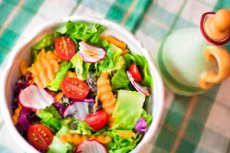
Esophagitis is one of the most common pathologies affecting the digestive tract. As a rule, this most often concerns the esophagus. Reflux (or return of food), for example, can occur when the muscular valve that blocks the passage between the esophagus and the stomach (cardiac sphincter) malfunctions. Due to its failure, some food, along with gastric juice, returns back to the esophagus, causing heartburn and discomfort in the throat, epigastric region and oral cavity. When diagnosing this pathology, one of the elements of the treatment process is a diet for reflux esophagitis, which, depending on the accompanying pathologies, is most often designated "Table No. 1" or "Table No. 5".
The essence of the diet for reflux esophagitis
Our gastrointestinal tract is initially developed by nature to process incoming food. Therefore, if it is damaged, the first thing you need to do is to review your diet, as well as the number and mode of meals. The essence of the diet for reflux esophagitis is that there is a significant restriction on the products allowed for use and the methods of their preparation.
In this case, a patient suffering from this pathology should eat at least four to six times a day, the portions consumed should be small in volume. The last meal should not be later than three to four hours before the expected time of going to bed.
You should also avoid taking a nap immediately after your stomach is full of food. You should sit or move slightly for about an hour, but this should not involve bending over or heavy physical exercise. Only then can you lie down. This approach will activate the evacuation of food from the stomach to the intestines, which will reduce the risk of a portion of food and stomach acid returning to the esophagus.
Products that cannot become catalysts for heartburn are allowed for cooking. But the diet must be balanced and "not recommended products" must be replaced with "acceptable" products of equal energy content.
You should not allow yourself to overeat, overloading your digestive tract with increased stress.
Our body is individual. Therefore, it can react differently to one product. In order to recognize the heartburn triggers directly for a specific organism, you should observe which of the products causes such a pathological response of the stomach. Perhaps these are fresh vegetables. Then you should try to heat-treat them. For example, a baked apple is tasty and healthy, while it does not cause unpleasant sensations in the epigastric region. You can consume berries and fruits in the form of compotes and soufflés.
In case of exacerbation of the pathological process, the attending physician usually transfers the patient to dietary “Table No. 1” - this is a fairly strict diet with significant restrictions.
In addition to those already voiced, there are also a number of general recommendations:
- Immediately before a meal, you should drink a glass of clean, cold, pre-boiled water. This will help to slightly reduce the acidity level and prevent the return of food.
- You should not drink alcoholic beverages before meals.
- The temperature of the food should be moderate: not too high and not too low.
- You can also reduce the likelihood of reflux by eating a few pieces of potato before a meal (the root vegetable is peeled and eaten raw). It can be replaced with two walnut kernels, a small slice of white bread, or one-fourth of a glass of potato juice.
- You should forget about the habit of eating at night - this only provokes another attack of heartburn.
- If an attack of reflux esophagitis occurs with severe pain symptoms, then such a patient should eat standing up, and after a meal, not take a lying position for at least three hours. You can walk or sit. In this position, food gets into the stomach faster and is also excreted from the stomach into the intestines in a more limited period of time.
- Before going to bed (in the evening), you can drink a decoction made from chamomile. It is easy to make at home using the classic method: take a glass of just-boiled water per tablespoon of the herb. Place this solution in a water bath and leave for 15 minutes. After it cools, you can strain it. The composition is ready for use. Chamomile has anti-inflammatory properties, and can have a calming effect on both the mucous membrane of the gastrointestinal tract and the nervous system. Therefore, sleep after a glass of tincture will be stronger and more complete.
- You should also avoid wearing hard and tight belts around your waist. This recommendation is especially relevant during an exacerbation of the disease. By squeezing the digestive tract, the belt can cause another reflux attack.
Now we should take a closer look at the foods that are welcome on the patient’s table, and those that should temporarily or permanently disappear from his diet.
Diet for reflux esophagitis and gastritis
If a person is periodically bothered by belching, bringing with it heartburn in the epigastric region, esophagus and oral cavity - this is a signal from the body to seek advice from a specialist, a doctor - a gastroenterologist. He will conduct the necessary research, and only after receiving a complete picture of the disease, can he make a diagnosis.
If gastritis with esophagitis is diagnosed, the attending physician introduces mandatory restrictions in nutrition. The diet for reflux esophagitis and gastritis is quite consistent with the requirements that have already been discussed above.
Mostly, such patients are prescribed dietary “Table No. 1” (in rarer cases, the doctor may prescribe “Table No. 5”).
"Table No. 1" is designed for patients suffering from gastric and duodenal ulcers, chronic gastritis with dyspeptic symptoms.
"Table No. 5" - pathological damage to the liver and biliary tract.
Nutrition for gastritis and esophagitis involves limiting the products listed above. At the same time, the stomach, against the background of the disease, should not be filled too much, especially overeating is unacceptable.
You should eat little by little, half filling your stomach. This approach to eating will allow you not to go hungry, which is also dangerous with this disease, and at the same time will not put too much strain on the diseased organ.
It is advisable for such a patient to start their day with jelly or banana. They will start the stomach. Jelly has enveloping properties, which is important in such a situation. Low-fat yogurt or light cottage cheese will also do. The main meals can be more substantial, but not heavy. These are light soups and cream soups, milk porridges and porridge-mess.
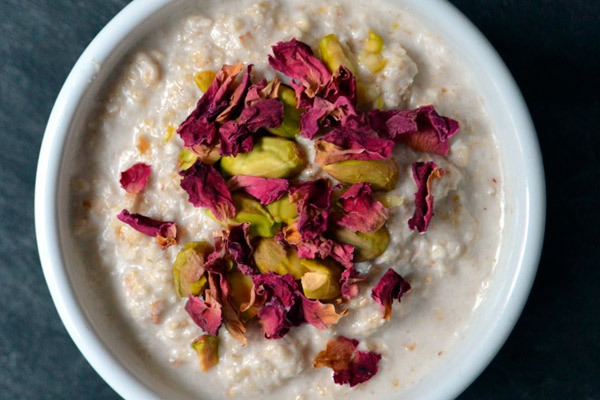
For an afternoon snack or lunch, you can eat a baked apple or pumpkin with apple. It is not only tasty, but also healthy.
Diet for catarrhal reflux esophagitis
Esophagitis is a disease that is an inflammatory process affecting the mucous membrane of the esophagus. Its most common form is catarrhal, leading to swelling and hyperemia of the inner wall of the esophagus, right up to the muscular valve separating it from the stomach.
This clinical picture requires mandatory medical intervention, one of the elements of which is a diet for catarrhal reflux esophagitis.
In this case, the dietary nutrition is gentle. Mostly, the doctor prescribes "Table No. 1" according to Pevzner to such a patient.
The main purpose of such a restriction is to reduce irritation and stop the inflammatory process in the esophageal mucosa. It is designed for normal production of gastric secretion and activation of the motility of the digestive organs.
Diet No. 1 is balanced and allows a person to receive the daily norm of all necessary substances, while the load on the gastrointestinal tract is insignificant. Products that stimulate gastric secretion, are difficult to process, too hot and too cold dishes, as well as those that irritate the mucous membrane of the tract are removed from the diet.
Table No. 1 involves taking small portions, but five to six times throughout the day. The interval between meals should not exceed four hours. The last meal should be no later than an hour and a half before bedtime, but it is desirable that this interval be maintained longer. Immediately before bedtime (the last meal), you are allowed to drink a glass of kefir, fermented baked milk, low-fat yogurt.
Most of the dishes that make up diet #1 are pureed, strained, liquid, porridge-like. Boiled or steamed fish and light meat in pieces are allowed. Such products can also be baked, but eaten without the skin.
Products that cause increased gas formation and irritate the mucous membrane of the esophagus and other parts of the digestive tract should be excluded from the diet.
Hard and not quite ripe vegetables, fruits and berries, cartilaginous tissue, skin of poultry, meat and fish, as well as bakery products made from coarse flour are not recommended for consumption.
Recommended:
Lean meat (only lean) in the form of quenelles, cutlets, soufflés, meatballs:
- Veal and turkey.
- Rabbit and chicken.
- Pork and lamb.
Lean fish (mainly sea fish).
Any porridge with water (mash) or milk.
Various soups, but cooked in water, not in heavy broth.
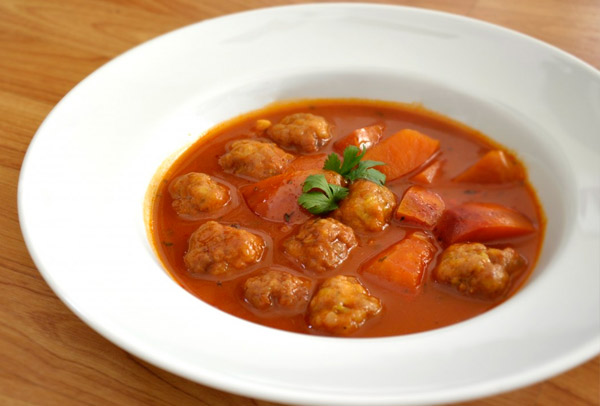
All kinds of side dishes:
- Boiled pasta.
- Mashed potatoes.
- Stewed vegetables.
Almost all fermented milk and dairy products have a low fat content.
Appetizers:
- Salads based on boiled vegetables.
- Steamed omelettes.
- Meat and fish pates.
- Jellied fish or beef tongue.
From fats:
- Any refined vegetable oil.
- Butter without added salt.
- Melted.
Diet for erosive reflux esophagitis
If the patient is diagnosed with erosive esophagitis, the diet should be reviewed. It should be gentle to the gastrointestinal mucosa affected by erosions. The diet developed for erosive reflux esophagitis should not irritate the tissues of the digestive organs and not stimulate the production of gastric secretion (hydrochloric acid), the increased content of which adversely affects the tissues, causing them increasing harm. The products allowed in it should not allow a decrease in the tone of the esophageal sphincter, provoking reflux return of food. Dishes should be easy to process and utilize, not lingering in the stomach for a long time.
Meals, as in previous cases, are fractional but frequent. That is, five or six meals in small portions. All food must be warm: neither too hot nor too cold are allowed. High and low temperatures provoke thermal irritation, which is unacceptable for the disease in question.
Almost all dishes must be pureed, chopped, soft and easily digestible. At the same time, the stomach should not feel heavy after eating, but should be half full. Overeating and hard-to-digest food are not allowed.
Cooking method: stewing, boiling, steaming and baking.
The list of permitted and prohibited products is quite consistent with the one presented in this article above.
During the course of treatment, you should, if possible, refrain from smoking and drinking various alcoholic beverages, which are powerful irritants to the mucous membrane.
Following all the recommendations in nutrition will significantly reduce the period of therapy and further recovery. Such nutrition will not only stop esophagitis, but also to a certain extent improve the health of the patient's entire body.
Diet for exacerbation of reflux esophagitis
The period of exacerbation of any pathology is a dangerous and responsible moment, bringing the patient many uncomfortable minutes and hours. In terms of the problem under consideration, exacerbation of esophagitis is especially noticeable. When taking any food, the patient feels acute pain, appetite decreases, the desire to eat disappears. But this is unacceptable, because the body needs energy and nutrients to strengthen the immune system and the ability to fight the disease.
Since it is food that brings the greatest discomfort to the patient and irritates the mucous membrane of the digestive tract even more, the diet for exacerbation of reflux esophagitis involves the introduction of fairly strict dietary restrictions. Absolutely all fruits, berries and vegetables are excluded from it. The patient is transferred to light mucous porridges cooked in water. They are energy-efficient for the body. At the same time, their mucous base has an enveloping effect on the inner walls of the gastrointestinal tract, which protects them from the action of acid, which is produced by gastric secretions for digestion of food. Basically, such porridges are prepared on the basis of rice grains and oats. During this period, the patient's diet can be diversified with derivatives of fermented milk products: low-fat mashed cottage cheese, curdled milk, yogurt, fermented baked milk, kefir. Fermented milk substances activate the digestion of food and normalize the balance of microflora in the intestine. Of the liquids, preference should be given to clean water, decoctions of rose hips and medicinal herbs (based on chamomile, calendula, sage and others), which have healing, anti-inflammatory properties, and a calming effect on the mucous membrane. But self-medication should not be done. Everything, including herbs, should only be prescribed by a specialist. After all, many people do not even think that if medicinal herbs are able to heal, then, accordingly, if used incorrectly, they can also cause harm. There are also a number of rules that should be followed if the patient wants to quickly stop the problem:
Three meals a day should be replaced with five or six meals a day.
The amount of food consumed per meal should be small, so as to satisfy hunger, but not to overeat, filling the stomach only a third. This way the body will receive nutrients and energy, but at the same time the digestive tract will not be overloaded.
To reduce the likelihood of reflux esophagitis symptoms, drink 200 ml of cool clean water 30 minutes before the expected meal. It will dilute the gastric secretion, making it less concentrated. At the same time, a glass of liquid, taking up part of the stomach volume, will not allow you to eat more food than necessary. During the process of eating, you should adhere to the accepted nutritional standards:
- Grind the food thoroughly using chewing movements.
- Eat slowly.
- During a meal, you should not talk or distract yourself by playing on a laptop, watching TV, reading a book or newspaper. 3. It is not recommended to lie down immediately after finishing a meal. This only increases the risk of the stomach contents returning back to the esophagus. It is better to sit or move, while avoiding sudden bends and heavy physical exertion.
- During this period, you should not wear tight belts around your waist. They put pressure on the epigastric region, making it difficult for food to pass through the digestive tract and causing gastric juice to flow into the esophagus. The same applies to tight, uncomfortable clothing.
Diet menu for reflux esophagitis
If a person already has experience in compiling a daily menu when diagnosing the disease in question, it will not be difficult for him to write it out again. But if such experience is absent, then at first it will be difficult to do. We are ready to offer several options for a daily menu for a diet for reflux esophagitis, using which it will be much easier for the patient to understand its principle and in the future learn to compose it independently.
Monday
Breakfast:
- Soft-boiled egg.
- Weak tea with milk.
Lunch:
- Rice pudding.
- Pear juice.
Dinner:
- Light vegetable puree soup with celery.
- Mashed potatoes.
- Stewed pieces of pollock.
- A glass of skim milk.
Afternoon snack – raspberry jelly.
Dinner:
- Liver stewed in sour cream.
- Green salad.
Just before bed – kefir.
Tuesday
Breakfast:
- Baked apples.
- Herbal tea.
Lunch:
- Biscuit cookies.
- A slice of low-fat hard cheese.
- Peach juice.
Dinner:
- Vegetable soup.
- Steamed meatballs with broccoli.
- Dried fruit compote.
Afternoon snack – raspberry jelly.
Dinner:
- Chicken breast baked with vegetables.
Just before bed – yogurt.
Wednesday
Breakfast:
- Fruit smoothie.
- Crackers.
Lunch - baked pumpkin with apple.
Dinner:
- Stewed potatoes.
- Chicken fillet.
- Beetroot salad with prunes.
- Rosehip decoction.
Afternoon snack – fruit salad.
Dinner:
- Fish fricassee.
- Stewed vegetables.
Just before bed – yogurt.
Thursday
Breakfast:
- Oatmeal is a mess.
- Berry jelly.
Lunch
- Tea brewed weakly with the addition of milk.
- Biscuit cookies.
Dinner:
- Fish soup made with water, not rich broth.
- Boiled turkey.
- Cabbage cutlet.
- Fruit jelly.
- Crackers.
Afternoon snack – apple sorbet.
Dinner:
- Pumpkin puree soup.
- Steamed cutlet.
Just before bed – fermented baked milk.
Friday
Breakfast:
- Boiled rice.
- Soft-boiled egg.
- Fruit fresh.
Lunch - grated carrots seasoned with vegetable oil.
Dinner:
- Fish baked on a vegetable bed.
- Carrot and beetroot caviar
- Fruit puree.
Afternoon snack – banana soufflé.
Dinner:
- Steamed fish with broccoli.
- Light green pillow.
Just before bed – kefir.
Saturday
Breakfast:
- Corn porridge.
- A piece of hard cheese (not fatty).
- Rosehip decoction.
Lunch - pear dessert.
Dinner:
- Baked potatoes.
- Meat medallions.
- Stewed cabbage.
- Fruit compote.
Afternoon snack: cottage cheese casserole with raisins and jam.
Dinner:
- Stuffed zucchini.
Just before bed – milk.
Sunday
Breakfast:
- Pearl barley porridge with stewed carrot and onion mixture.
- Weak black tea.
Lunch – apple and banana sorbet.
Dinner:
- Stew.
- Buckwheat porridge.
- Carrot salad.
- Freshly squeezed juice.
Afternoon snack – pancakes with vegetable filling.
Dinner:
- Boiled fish baked under béchamel sauce
- Pumpkin stewed with vegetables.
Just before bed – kefir.
I hope that the menu options provided will help all those interested to create their own diet and forget about the unpleasant symptoms of reflux forever.
Diet recipes for reflux esophagitis
Once the diagnosis is made, the doctor prescribes medication to the patient, as well as a diet, which he must adhere to. Otherwise, it will be difficult to achieve a therapeutic effect. In this article, we are ready to offer some recipes for a diet for reflux esophagitis, which, without violating the recommendations, should appeal to people suffering from the disease in question.
Meat (liver) pate
Compound:
- Suitable meat: chicken, turkey, beef, liver - 300 g
- Carrot - one
- Onion - one
- Butter
Manufacturing sequence:
Boil the meat (or liver), onion and carrot until fully cooked. Cool all ingredients and grind several times in a meat grinder or blender until smooth. You can take part of the meat and part of the liver. Add butter to the resulting mass to taste. Stir.
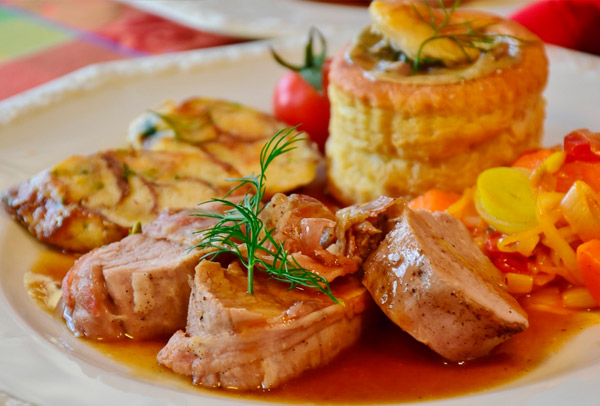
Vegetarian soup with pearl barley
Compound:
- Pearl barley - 20 g
- Vegetable broth – 300 – 400 ml
- Potatoes – 65 g
- Carrots – 35 g
- Sour cream (15% fat and below) – 20 g
- Green
- Butter
Manufacturing sequence:
Wash the pearl barley thoroughly and cook for three hours until fully cooked. Peel and chop the carrots, place in the hot vegetable broth and simmer. Add the peeled and diced potatoes. Leave on low heat until fully cooked. Add the pearl barley to the cooked vegetables and add salt. You can add herbs and sour cream directly to the plate.
Banana - Pear Smoothie
Compound:
- Pear - two
- Bananas - three
- Celery stalk - two
- Water - glass
Manufacturing sequence:
Pour water into a blender and add the remaining ingredients. Mix everything well. The drink is ready.

Morning Fruit Smoothie
Compound:
- Kiwi - three
- Bananas - one
- Raspberries – 100 g
- Hazelnuts (filberts) - a dozen
- Natural honey (preferably flower honey) – a tablespoon
Manufacturing sequence:
Place kiwi, banana and raspberry in a blender, beat everything well and pour into a glass. Add honey and sprinkle with nuts, which were previously ground in a blender or coffee grinder to fine crumbs.
Fruit soup with croutons
Compound:
- Strawberries – 100 g
- Potato flour (starch) – 10 g
- Granulated sugar – 30 g
- White bread (for croutons) – 40 g
- Water
Manufacturing sequence:
Inspect the berries, removing any spoiled or rotten ones. Wash them thoroughly in several portions of cold boiled water. Squeeze the juice out of 50 g of strawberries and place it in a cool place. Pour a small amount of hot water over the remaining pulp. Boil for a bit and strain. Add sugar.
Dilute the starch with water and add to the berry broth. Put on low heat and, stirring, bring to a boil, immediately remove from heat. Add cooled juice and 50 g of the remaining whole berries. Place the dish in the refrigerator.
Separately cut white bread into small pieces and dry. Serve with strawberry soup.
Steamed meatballs
Compound:
- Lean meat pulp – 125 g
- White bread – 20 g
- Butter – 5 g
- Salt
- Water – 15 g
Manufacturing sequence:
Rinse the meat, dry it with a kitchen towel, remove the ligaments and membrane. Mince the prepared pieces twice. Soak the white bread in water, squeeze out the excess liquid. Add to the meat and mince twice again.
Add salt to the mince and beat it: take the mince in your hands and throw it on a cutting board or other dish. Do this several times. Roll the nuts out of the resulting mixture. This amount usually yields 10-12 pieces.
Place the meatballs in a colander and steam them under a lid, or place them in a saucepan and steam them in a small amount of water (the liquid you pour in must be hot).
Once on the plate, the meatballs are poured with melted butter.
Potato cutlets stuffed with meat
Compound:
- Potato tubers – 300 g
- Lean meat pulp – 70 g
- Onions – 15 g
- Bakery product made from white flour (for croutons and breading) – 20 g
- Egg - half
- Butter (vegetable) – 10 g
- Salt
- Sour cream (use not very fat) – 10 g
Manufacturing sequence:
Rinse the piece of meat, dry it with a kitchen towel, remove ligaments, fat layers (if any) and membrane. Boil until done, remove from heat and cool. Grind the prepared pieces of boiled meat twice on the meat grinder grate. Add salt and butter to the mixture.
Peel the onion and cut it into small pieces for sautéing. Simmer it in a heated frying pan in vegetable oil for several minutes until golden brown. Add to the meat mixture and mix thoroughly. The filling is ready.
Peel and boil the potatoes. Mince, but it is better to grind them by rubbing through a sieve. Add salt and add a raw egg. Knead.
Make portioned pancakes from the potato mass. Put the onion and meat filling in the middle and form the zrazy.
Make crackers from white bread and use them to make breading, which you can use to bread the potato cutlets.
Grease a baking dish with butter and put the zrazy in it. Pour sour cream on top and bake in a preheated oven.
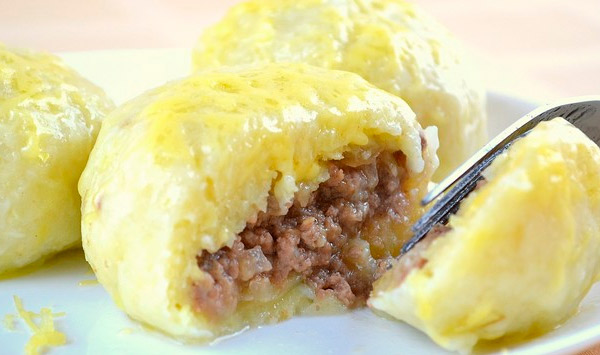
Milk Noodle Soup
Compound:
- Flour – 40 g
- Butter – 5 g
- Water
- Salt - a pinch
- Milk – 300 ml
- Granulated sugar – 5 g
Manufacturing sequence:
Make dough using egg, flour and water. After it is well kneaded, roll it into a thin layer and leave it on the table for a while so that the layer dries out a little. This will make it easy to cut the dough into noodles (they will not stick together). Cut the dough into strips. Pour water into a saucepan and bring it to a boil, throw in the noodles and cook for 10-15 minutes. Add milk. Salt the soup, add sugar and set it off the heat to the edge of the stove. The milk soup is ready. Put a small piece of butter directly into the bowl of noodle soup.
Fish seasoned with béchamel sauce
Compound:
- Fish fillet – 100 g
- Butter – 5 g
- Hard cheese – 5 g
- Milk – 50 ml
- Salt - a pinch
- Flour – 5 g
Manufacturing sequence:
Pike perch is especially good with this sauce. Clean the fish, rinse well under running water and remove all the bones. Cut into portions. Pour water into a saucepan, bring it to a boil and add the fish, boiling it until done.
Béchamel sauce is easy to make: boil milk and carefully add flour to thicken it. You can add a little salt.
Grease a baking tray with oil, distribute the fish pieces on it, pouring white sauce over them. Sprinkle with grated hard cheese on top and sprinkle with melted butter. Place in a preheated oven.
 [ 16 ]
[ 16 ]
Steamed curd soufflé
Compound:
- Cottage cheese (low fat) – 100 g
- Butter – 5 g
- Egg - half
- Flour (can be replaced with semolina or take 1:1) – 10 g
- Milk – 25 ml
- Sour cream (use not very fat) – 20 g
- Granulated sugar – 20 g
Manufacturing sequence:
Rub fresh curd cheese using a meat grinder with a small grate or sieve. Transfer the curd "dough" into a container, add yolks, flour and/or semolina, sugar - mix everything well, adding milk.
Cool the whites, after which they easily whip into a steep foamy structure. We introduce them into the curd mass very carefully, mixing with a wooden or silicone spatula clockwise and from the bottom up.
Prepare the form by greasing it with oil and put the curd dough in it. Place in a steam bath and bring to readiness.
The cottage cheese pie can be served with sour cream.
Eating on the run, eating fast food and instant food, constant stress that haunts the modern population (especially in big cities) could not but affect the condition of the human body. Pathologies of various kinds are getting younger and becoming more widespread. But the first thing that suffers from poor-quality, irrational food is the mucous membrane of the digestive tract. If a person begins to suffer from unpleasant symptoms, for example, in the form of burning and pain in the epigastric region, belching, bringing discomfort to its owner, it is necessary to consult a gastroenterologist. Almost everyone knows that one of the elements of stopping the problem, without fail, is a diet for reflux esophagitis, which should be followed if the patient wants to quickly cure the disease and return to a normal, full life. It should only be noted that it and all complex treatment should be prescribed only by a qualified specialist, and only after a full examination of the patient, obtaining a general clinical picture of the disease and establishing a diagnosis. Take care of yourself and be healthy!
What can you eat with reflux esophagitis?
In order for nutrition to become a "medicine" and not, on the contrary, provoke the development of the disease, the patient and his relatives should know those products and methods of cooking that can support the sick organism, will become the basis on which recovery will take place. So what can you eat with reflux esophagitis?
- Small portions of food should be washed down with mineralized water without gas or ordinary warm boiled water. Freshly brewed tea (not strong), non-acidic freshly squeezed juices will do, but the most preferable drink in such a situation is milk (if the body accepts this product), as well as a vitaminized infusion of rose hips. It is easy to get such a nutritious infusion by pouring boiling water over the berries and placing them in a thermos. Wait about six hours and the healthy drink is ready. The ideal ratio is two tablespoons of dry rose hips per liter of water. After that, the liquid can be drunk instead of tea.
- It is also possible to replenish moisture with compotes (from fruits and dried fruits), mousses, fruit kissels and punches.
- The diet of such a patient must include fermented milk products (low-fat). They are not only nutritious, but also help to normalize intestinal motility, preventing food stagnation and constipation of feces. And regular bowel movements help to avoid more unpleasant complications and consequences for the sick organism, including intoxication of the organism.
- It is worth giving preference to lean porridges or dishes with milk. Wheat groats and oat flakes have an advantage here.
- It is allowed to eat soft-boiled eggs. But you should not get carried away with them. They should be eaten no more than one every one or two days.
- Sweet fruits can also relieve an attack of heartburn. But this is strictly individual. It is advisable to eat them on an empty stomach, in the morning. These can be:
- Bananas and pears.
- Sweet apples and apricots.
- Peach and nectarine.
- Cherry and others.
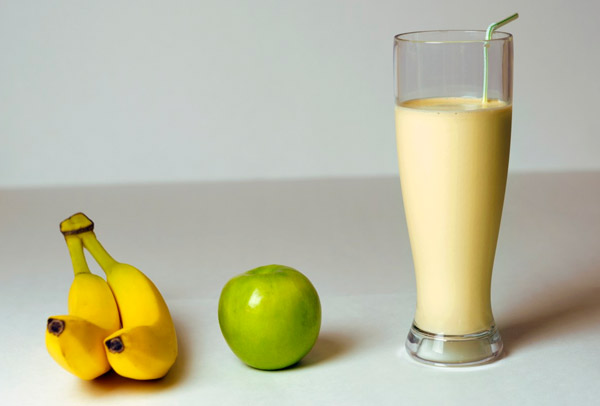
- You can eat boiled, mashed lean meat.
- Minced lean meat or steamed fish dishes are allowed:
- Cutlets and zrazy.
- Meatballs and soufflé.
- It is better to eat dried bread, yesterday's. If it is hard, it should be soaked in milk or water before eating.
- Light vegetable and pureed soups.
The main type of cooking allowed for the disease in question is steaming, boiling and mashed dishes; in rarer cases, baking of products is allowed.
When prescribing a diet for reflux esophagitis, the attending gastroenterologist must take into account the characteristics of the patient's body, giving him individual recommendations.
What should you not eat if you have reflux esophagitis?
Mostly any diet involves a number of restrictions that negatively affect the patient's body, only worsening his condition. So, what can't you eat with reflux esophagitis? The answer to this question should be known by both the patient and his loved ones. Therefore, this list should be voiced. First of all, these are products that provoke increased gas formation in the abdomen:
- Legumes:
- Green peas.
- Beans and legumes.
- Lentils.
- Sauerkraut, fresh cabbage and pickled cabbage. It is very heavy for the stomach and contributes to increased bloating.
- Alcohol and carbonated drinks are strictly prohibited.
- Mushrooms.
- Reduce consumption of fresh vegetables, berries and fruits.
- Rich, heavy broths.
- Sour juices.
- Store-bought croutons.
- Hot and overly spicy seasonings and sauces.
- Black bread.
- Turnips, radishes and cucumbers.
- Products enriched with stabilizers, dyes and other chemical compounds, designated by the letter "E" followed by numbers.
- Chocolate and food products based on it.
- Coffee, cocoa, strong tea.
- Smoked meats, marinades and pickles.
- Citrus fruits and tomatoes.
- Chips and nuts.
- Garlic and fresh onions.
- High-fat foods: meat, fish, dairy and fermented milk products.
- Sweet fresh baked goods.
- Beer, kvass.
- Vinegar.
Many of the listed products lead to increased intra-abdominal and intra-gastric tension, which provokes the reflux of stomach contents back into the esophagus. Therefore, this list should be kept in mind when compiling a diet menu for a person suffering from reflux esophagitis.
Some of the above products irritate the intestinal mucosa, causing inflammation, which cannot but affect the condition of the digestive tract.
You should more closely monitor your body's reaction to a particular product. If there is an individual intolerance to a specific product, it should also be included in the list of prohibited ones. In order not to harm your health, the patient should listen to the advice of a gastroenterologist, who, if necessary, can also adjust the diet.

